TAYLOR DD 94
Ship Name and Designation History
This section lists the names and designations that the ship had during its lifetime. The list is in chronological order.
- USS TAYLOR Destroyer No. 94
Commissioned 1 June 1918
- USS TAYLOR DD 94
Designated (DD) 17 July 1920
Decommissioned 21 June 1922
Recommissioned 1 May 1930 - Decommissioned 23 September 1938
Struck from Naval Register 6 December 1938
- DAMAGE CONTROL HULK No. 40
Reclassified 11 July 1940
TAYLOR's bow was used to repair BLAKELEY DD-150 in 1942 when a German torpedo took off 60 feet of her bow.
Sold 8 August 1945 and broken up for scrap
Wickes Class Destroyer
Keel Laid 15 October 1917 - Launched 27 December 1917
Naval Covers
This section lists active links to the pages displaying covers associated with the ship. There should be a separate set of pages for each incarnation of the ship (ie, for each entry in the "Ship Name and Designation History" section). Covers should be presented in chronological order (or as best as can be determined).
Since a ship may have many covers, they may be split among many pages so it doesn't take forever for the pages to load. Each page link should be accompanied by a date range for covers on that page.
- USS Taylor DD-94 Covers Page 1 (1933-1938)
Postmarks
This section lists examples of the postmarks used by the ship. There should be a separate set of postmarks for each incarnation of the ship (ie, for each entry in the "Ship Name and Designation History" section). Within each set, the postmarks should be listed in order of their classification type. If more than one postmark has the same classification, then they should be further sorted by date of earliest known usage.
A postmark should not be included unless accompanied by a close-up image and/or an
image of a cover showing that postmark. Date ranges MUST be based ONLY ON COVERS IN
THE MUSEUM and are expected to change as more covers are added.
>>> If you have a better example for any of the postmarks, please feel free to replace the
existing example.
|
Postmark Type |
Postmark Date |
Thumbnail Link To Postmark Image |
Thumbnail Link To Cover Image |
|---|
2nd Commissioning 1 May 1930 to 23 September 1938
|
Locy Type |
1938-02-04 |
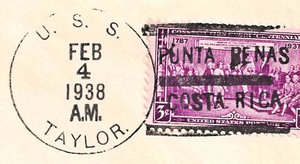 |
 |
Note:
|
Locy Type |
1933-03-05 |
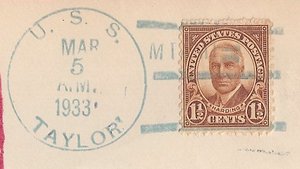 |
 |
Food & Home Exposition. Cachet by David Rosenthal, sponsored by Miami Philatelic Society
|
Locy Type |
1933-06-24 |
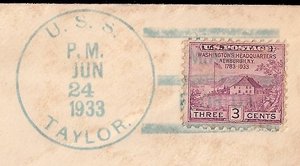 |
 |
Midshipmen Cruise. Cachet by David Rosenthal, sponsored by Miami Philatelic Society
|
Locy Type |
1934-10-27 |
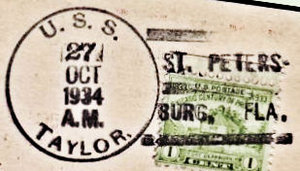 |
 |
Navy Day 1934.
|
Locy Type |
1934-11-24 |
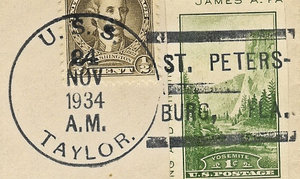 |
 |
President Zachary Taylor's birthday, cachet by Roy Hubbard
|
Locy Type |
1935-05-19 |
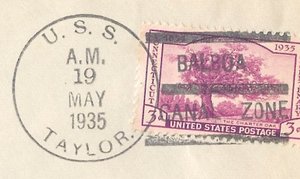 |
 |
Note:
|
Locy Type |
1935-09-20 |
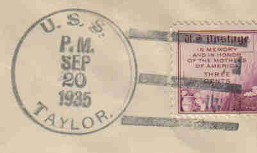 |
 |
Note:
|
Locy Type |
1935-12-25 |
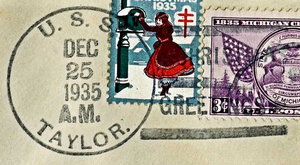 |
 |
Christmas
|
Locy Type |
1938-09-23 |
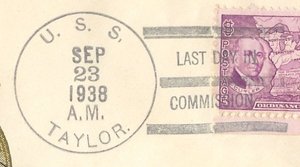 |
 |
Last Day of Commissioning, Cachet by William F. Schlechter. R/S marking on back from Walter Czubay.
|
Locy Type |
1938-09-23 |
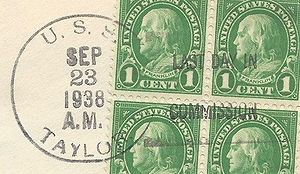 |
 |
Note:
Other Information
NAMESAKE - Rear Admiral Henry Clay Taylor, USN (4 March 1845 - 26 July 1904)
Taylor was born in Washington, D.C., in 1845. He was appointed midshipman at the Naval Academy on 28 September 1860. When the Civil War expansion of the Navy engendered a pressing need for junior officers in the fleet, Midshipman Taylor's class was graduated a year early. He was commissioned ensign on 28 May 1863 and posted to the steam sloop USS Shenandoah operating with the North Atlantic Blockading Squadron. In 1864, he was transferred to the sloop-of-war USS Iroquois, in which he visited the Mediterranean and participated in the hunt for the Confederate raider CSS Shenandoah. After the Civil War, Taylor served in a succession of ships on various stations. In 1866 and 1867, he was in USS Rhode Island with the North Atlantic Squadron, and he was assigned to USS Susquehanna from 1867 to 1868. His next tour of duty, in 1868 and 1869, was with the European Squadron in the storeship USS Guard. Between 1869 and 1880, Taylor sandwiched two tours at sea in between two periods of shore duty. His first assignment ashore, in 1869, 1870, and 1871, was at the Naval Academy. Following that, he was executive officer of USS Saranac, the flagship of the Pacific Squadron, from 1872 to 1874. Over the next three years, Lt. Comdr. Taylor commanded the Coast Survey steamer Hassler. In 1877, he came ashore once more, this time assigned to the Hydrographic Office. From there, he went to the Washington Navy Yard where he was serving at the time of his promotion to commander in December 1879. In 1880, Comdr. Taylor resumed sea duty as the commanding officer of USS Saratoga. In 1884 and 1885, he was on special duty at New York City. From 1885 to 1887, Comdr. Taylor served as a member of the Board of Inspection and then took a leave of absence in 1888. In 1890, he returned to duty to command USS Alliance on the Asiatic Station until September 1891 when he took another leave of absence until December 1892. After six months special duty in 1893, Comdr. Taylor became President of the Naval War College. In April 1894, he was promoted to Captain. Capt. Taylor assumed command of USS Indiana (Battleship No. 1) in December 1894. His ship was assigned to the North Atlantic Squadron, and he commanded her through the Spanish-American War in 1898. In the fall of 1899, Capt. Taylor was detached from USS Indiana and assigned to shore duty. In March 1900, he became a member of the General Board and, 11 months later on 11 February 1901, he was promoted to Rear Admiral. On 29 April 1902, he assumed the post of Chief of the Bureau of Navigation, which he held until his death on 26 July 1904.
The ships sponsor was Miss Mary Gorgas.
If you have images or information to add to this page, then either contact the Curator or edit this page yourself and add it. See Editing Ship Pages for detailed information on editing this page.
Copyright 2025 Naval Cover Museum